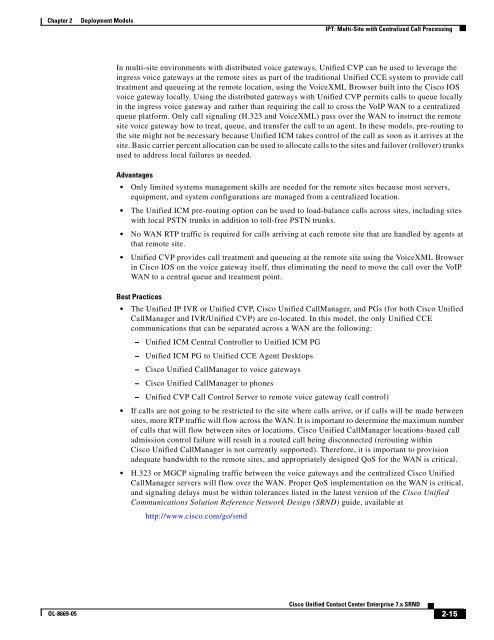Cisco Unified Contact Center Enterprise Solution Reference ...
Cisco Unified Contact Center Enterprise Solution Reference ...
Cisco Unified Contact Center Enterprise Solution Reference ...
Create successful ePaper yourself
Turn your PDF publications into a flip-book with our unique Google optimized e-Paper software.
Chapter 2 Deployment Models<br />
OL-8669-05<br />
IPT: Multi-Site with Centralized Call Processing<br />
In multi-site environments with distributed voice gateways, <strong>Unified</strong> CVP can be used to leverage the<br />
ingress voice gateways at the remote sites as part of the traditional <strong>Unified</strong> CCE system to provide call<br />
treatment and queueing at the remote location, using the VoiceXML Browser built into the <strong>Cisco</strong> IOS<br />
voice gateway locally. Using the distributed gateways with <strong>Unified</strong> CVP permits calls to queue locally<br />
in the ingress voice gateway and rather than requiring the call to cross the VoIP WAN to a centralized<br />
queue platform. Only call signaling (H.323 and VoiceXML) pass over the WAN to instruct the remote<br />
site voice gateway how to treat, queue, and transfer the call to an agent. In these models, pre-routing to<br />
the site might not be necessary because <strong>Unified</strong> ICM takes control of the call as soon as it arrives at the<br />
site. Basic carrier percent allocation can be used to allocate calls to the sites and failover (rollover) trunks<br />
used to address local failures as needed.<br />
Advantages<br />
Only limited systems management skills are needed for the remote sites because most servers,<br />
equipment, and system configurations are managed from a centralized location.<br />
The <strong>Unified</strong> ICM pre-routing option can be used to load-balance calls across sites, including sites<br />
with local PSTN trunks in addition to toll-free PSTN trunks.<br />
No WAN RTP traffic is required for calls arriving at each remote site that are handled by agents at<br />
that remote site.<br />
<strong>Unified</strong> CVP provides call treatment and queueing at the remote site using the VoiceXML Browser<br />
in <strong>Cisco</strong> IOS on the voice gateway itself, thus eliminating the need to move the call over the VoIP<br />
WAN to a central queue and treatment point.<br />
Best Practices<br />
The <strong>Unified</strong> IP IVR or <strong>Unified</strong> CVP, <strong>Cisco</strong> <strong>Unified</strong> CallManager, and PGs (for both <strong>Cisco</strong> <strong>Unified</strong><br />
CallManager and IVR/<strong>Unified</strong> CVP) are co-located. In this model, the only <strong>Unified</strong> CCE<br />
communications that can be separated across a WAN are the following:<br />
– <strong>Unified</strong> ICM Central Controller to <strong>Unified</strong> ICM PG<br />
– <strong>Unified</strong> ICM PG to <strong>Unified</strong> CCE Agent Desktops<br />
– <strong>Cisco</strong> <strong>Unified</strong> CallManager to voice gateways<br />
– <strong>Cisco</strong> <strong>Unified</strong> CallManager to phones<br />
– <strong>Unified</strong> CVP Call Control Server to remote voice gateway (call control)<br />
If calls are not going to be restricted to the site where calls arrive, or if calls will be made between<br />
sites, more RTP traffic will flow across the WAN. It is important to determine the maximum number<br />
of calls that will flow between sites or locations. <strong>Cisco</strong> <strong>Unified</strong> CallManager locations-based call<br />
admission control failure will result in a routed call being disconnected (rerouting within<br />
<strong>Cisco</strong> <strong>Unified</strong> CallManager is not currently supported). Therefore, it is important to provision<br />
adequate bandwidth to the remote sites, and appropriately designed QoS for the WAN is critical.<br />
H.323 or MGCP signaling traffic between the voice gateways and the centralized <strong>Cisco</strong> <strong>Unified</strong><br />
CallManager servers will flow over the WAN. Proper QoS implementation on the WAN is critical,<br />
and signaling delays must be within tolerances listed in the latest version of the <strong>Cisco</strong> <strong>Unified</strong><br />
Communications <strong>Solution</strong> <strong>Reference</strong> Network Design (SRND) guide, available at<br />
http://www.cisco.com/go/srnd<br />
<strong>Cisco</strong> <strong>Unified</strong> <strong>Contact</strong> <strong>Center</strong> <strong>Enterprise</strong> 7.x SRND<br />
2-15
















